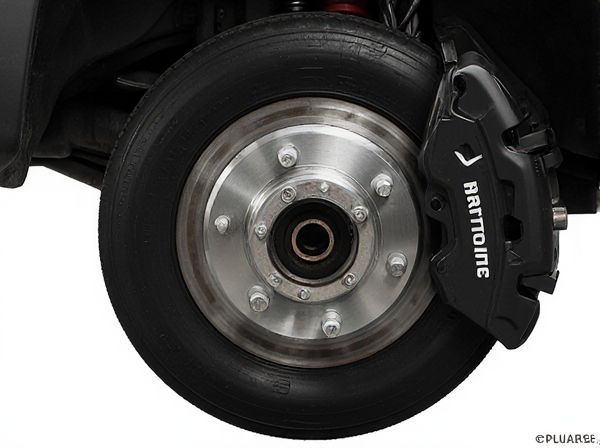
Photo illustration: Mechanical Handbrake vs Electronic Handbrake
Mechanical handbrakes rely on a manual lever or pedal to engage the braking system, providing direct control and reliability without electronic components. Electronic handbrakes activate via a switch and use motors to apply the brakes, offering convenience and integration with modern safety features like automatic hold. Understanding the differences helps you choose the best option based on your driving preferences and vehicle features.
Table of Comparison
| Feature | Mechanical Handbrake | Electronic Handbrake |
|---|---|---|
| Operation | Manual lever pull | Button-activated electronic control |
| Engagement Force | Physically applied by driver | Automatically applied via electric motor |
| Space Efficiency | Requires larger console space | Minimal space, compact design |
| Maintenance | Requires regular cable adjustment | Low maintenance, complex electronics |
| Safety Features | Basic mechanical hold | Includes auto-release, hill-hold assist |
| Installation Cost | Lower initial cost | Higher initial cost due to electronics |
| Reliability | Long-lasting, simple design | Dependence on electronic systems |
| User Experience | Traditional tactile feedback | Convenient, modern interface |
Introduction to Handbrake Systems
Handbrake systems serve as critical components for vehicle parking and emergency stopping functions, with mechanical handbrakes relying on a manual lever connected to brake cables to engage rear brakes. Electronic handbrakes, also known as electric parking brakes (EPB), utilize an electro-mechanical actuator controlled by a switch or button, enhancing convenience and integration with modern vehicle safety systems. Both types aim to prevent vehicle movement when stationary, but electronic handbrakes offer automated features such as auto-hold and hill-start assist, improving user experience and safety.
What is a Mechanical Handbrake?
A mechanical handbrake is a manual braking system activated by pulling a lever connected to the rear brakes through a cable mechanism. It provides direct physical control to the driver, allowing precise engagement and emergency stopping capability. Mechanical handbrakes are commonly found in older vehicles and performance cars requiring reliable parking brake functionality without electronic components.
What is an Electronic Handbrake?
An electronic handbrake, also known as an electronic parking brake (EPB), replaces the traditional mechanical lever with an automated system controlled by a button or switch. It uses electric motors to engage the brake pads, providing consistent and efficient braking force without manual effort. This system enhances safety through features like automatic release, hill hold assist, and integration with vehicle stability controls.
How Mechanical Handbrakes Work
Mechanical handbrakes operate using a physical lever connected to a cable system that directly engages the rear brake shoes or pads, generating friction to prevent vehicle movement. When the handbrake lever is pulled, tension in the cable tightens, forcing the brake components against the drum or disc, securing the wheels in place. This direct mechanical linkage ensures reliable parking brake performance independent of the vehicle's electronic systems.
How Electronic Handbrakes Operate
Electronic handbrakes operate through an electric motor that activates the braking mechanism, replacing the traditional manual lever and cable system found in mechanical handbrakes. When the driver presses a button, sensors signal the motor to apply the brakes with precise force, enhancing safety features like automatic release and integration with hill-start assist systems. This technology reduces physical effort and allows for advanced functionalities such as automatic parking brake application when the vehicle is switched off.
Advantages of Mechanical Handbrakes
Mechanical handbrakes offer superior reliability due to their simple, cable-operated design that is less prone to electronic failure. They provide precise manual control and immediate feedback, allowing drivers to engage the brake with varying force depending on the situation. Furthermore, mechanical handbrakes are often easier and less costly to repair or replace compared to complex electronic systems.
Benefits of Electronic Handbrakes
Electronic handbrakes offer enhanced safety through automatic engagement and hill-hold functions, reducing the risk of vehicle roll-back. They save cabin space and improve interior design flexibility by eliminating bulky lever mechanisms. Maintenance demands are lower compared to mechanical handbrakes, as electronic systems have fewer moving parts subject to wear.
Common Issues and Maintenance
Mechanical handbrakes often face cable stretch, corrosion, and misalignment, requiring regular adjustments and lubrication to maintain proper function. Electronic handbrakes may encounter electrical faults, sensor malfunctions, or software glitches, demanding diagnostic tools for troubleshooting and specialized repairs. Routine inspection of mechanical components versus electronic system updates ensures optimal performance and safety in both types.
Safety Considerations: Mechanical vs Electronic
Mechanical handbrakes offer direct cable-operated braking, providing reliable and immediate control in emergency situations, minimizing failure risks due to electronic malfunctions. Electronic handbrakes incorporate automatic engagement features and integration with vehicle stability systems, enhancing convenience but potentially introducing latency and dependence on electronic components that require regular diagnostics. Safety considerations favor mechanical systems for simplicity and robustness, while electronic handbrakes excel in driver assistance but demand consistent software and hardware maintenance to ensure optimal performance.
Which Handbrake System is Better for You?
Mechanical handbrakes offer direct, tactile control ideal for drivers who prioritize simplicity and reliability, especially in vehicles used for towing or off-road driving. Electronic handbrakes provide convenience with automatic engagement and integration into modern safety systems, enhancing ease of use in urban and daily commuting scenarios. Choosing the better system depends on your driving style, vehicle type, and preference for manual control versus technological assistance.
 caratoz.com
caratoz.com